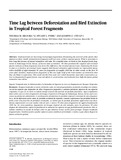Time Lag between Deforestation and Bird Extinction in Tropical Forest Fragments

View/
Date
1999Author
Pimm, Stuart L.
Brooks, Thomas M
Oyugi, Joseph O
Language
enMetadata
Show full item recordAbstract
ropical forests are becoming increasingly fragmented, threatening the survival of the species that
depend on them. Small, isolated forest fragments will lose some of their original species. What is uncertain is
how long this process of faunal relaxation will take. We compiled data on birds in five tropical forest frag-
ments in Kakamega Forest, Kenya, of known date of isolation. We then predicted the original and eventual
species richness of these fragments and, from this difference, the eventual species losses. Expressing the losses
to date as a fraction of eventual losses suggests that faunal relaxation approximates an exponential decay
with a half-life of approximately 50 years for fragments of roughly 1000 ha. In other words, in the first 50
years after isolation, tropical forest fragments of this size suffer half of the total number of extinctions that
they are likely to experience. This result sets the time scale over which humanity must take conservation ac-
tion in fragmented tropical forests, may aid efforts to set priorities, and indicates how high the future global
extinction rate will be.
Espacio Temporal entre la Deforestación y la Extinción de Especies de Aves en Fragmentos de Bosques Tropicales
Resumen:
Bosques tropicales se estan volviendo cada vez más fragmentados, poniendo en peligro la existen-
cia de las especies que dependen de ellas. Fragmentos pequeños y aislados perderán algunas de sus especies
originales. Lo que no es cierto es cuánto tiempo durará éste periodo de perdida faunística. Aquí compilamos
datos sobre aves en cinco fragmentos de bosque tropical en el Bosque de Kakamega, Kenya, de las cual cono-
cemos sus fechas de aislamiento. A continuación, predecimos la perdida original y eventual de estos fragmen-
tos y, de la diferencía entre estas, la perdida eventual de especies. Cuando expresamos las perdidas hasta la
fecha como una fracción de perdidas eventuales, se estima que la perdida faunística approxima una deca-
dencia exponencial con una media vida de más o menos 50 años para fragmentos de approximadamente
1000 ha. En otras palabras, fragmentos de bosque tropical de este tamaño, para los primeros 50 años
despues de aislamiento, sufren la perdida de la mitad de las especies de que probablemente perderán. Este re-
sultado establece la escala de tiempo sobre la que debemos tomar acción para proteger bosques tropicales
fragmentados. Tambien podra ayudar esfuerzos para establecer prioridades e indica a que altura llegará la
futura extinción global
URI
http://onlinelibrary.wiley.com/doi/10.1046/j.1523-1739.1999.98341.x/fullhttp://hdl.handle.net/11295/71825
Citation
Conservation Biology Volume 13, Issue 5, pages 1140–1150, October 1999Publisher
University of Nairobi
